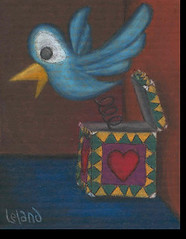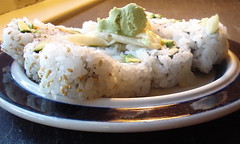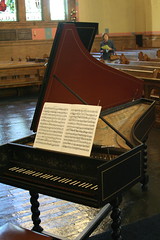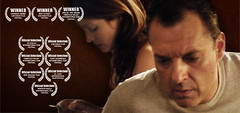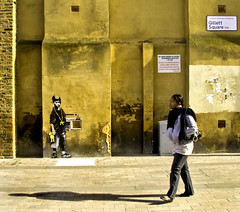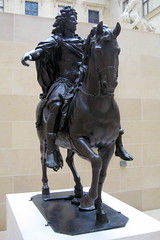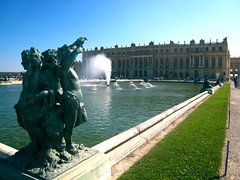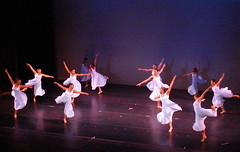Cuisine project (see below) due Mon. The last official 15 pt activity.
Exam: Wed, May 13
The Comprehensive School-Life Exam Essay
To think upon your high school years is to have a moment of reflection, which educators know is important. This writing is called An Awesome Essay (but you may Not use that as your title; come up with something original, like Upsidepineappledowncake).
* Examples of and areas of academic growth?
* Areas of greatest academic/emotional growth?
* Most effective learning styles for you?
* Your classes - and fields - of greatest strength?
* Which teaching activities enhanced your learning?
* Which teaching methods were counter-productive? And why?
You may write much of it in advance if that's important for you. At the very least, I'd say, write notes in advance.
Because I have students who would throw down 35 words and walk away, let me set a minimum: 600 words. That's about a page and a half.
Video? See me, please.
Thursday, April 30, 2009
Wednesday, April 29, 2009
Fine Arts Google Documents must include the following 11 essays and projects . . .
1. Photo project
2. Masks project
3. Norton Art Gallery essay
4. American Graffiti review
5. Funny Thing Happened on the way to the Forum (or equivalent) essay
6. Pop music history project
7. Glengarry Glen Ross essay
8. Who's Afraid of Virginia Woolf essay
9. Amadeus comparison essay - compare to Glengarry or to Woolf
10. Meadows Museum of Art essay (10)
11. Dallas Clayton essay (10)
12. Artful Cuisine project (15)
Indie work may be used as a substitute for missing essays. That would include essays on
- a local play, such as Steel Magnolias (Spt Little Theater)
- Shreveport Opera (Sat, May 2)
- visit to Artspace (Cuban art and paintings by Graham Mears upstairs)
- The Last Lullaby (Jeffrey Goodman movie) at la Bdwk this weekend.
- comparison of Leonard Bernstein and Martha Graham
- visit to Little Shanty Folk Art Gallery, Line Ave.
- a video production
- Review of local independent restaurant (ex, Golden Land Superior Thai food, Mona's Lebanese, Abby Singer's Bistro at RFC, etc)
- a foreign movie such as the French movie, The Class, at RFC.
Bon apetit!
Semester exam: the Exit Essay (see earlier description of what's expected).
2. Masks project
3. Norton Art Gallery essay
4. American Graffiti review
5. Funny Thing Happened on the way to the Forum (or equivalent) essay
6. Pop music history project
7. Glengarry Glen Ross essay
8. Who's Afraid of Virginia Woolf essay
9. Amadeus comparison essay - compare to Glengarry or to Woolf
10. Meadows Museum of Art essay (10)
11. Dallas Clayton essay (10)
12. Artful Cuisine project (15)
Indie work may be used as a substitute for missing essays. That would include essays on
- a local play, such as Steel Magnolias (Spt Little Theater)
- Shreveport Opera (Sat, May 2)
- visit to Artspace (Cuban art and paintings by Graham Mears upstairs)
- The Last Lullaby (Jeffrey Goodman movie) at la Bdwk this weekend.
- comparison of Leonard Bernstein and Martha Graham
- visit to Little Shanty Folk Art Gallery, Line Ave.
- a video production
- Review of local independent restaurant (ex, Golden Land Superior Thai food, Mona's Lebanese, Abby Singer's Bistro at RFC, etc)
- a foreign movie such as the French movie, The Class, at RFC.
Bon apetit!
Semester exam: the Exit Essay (see earlier description of what's expected).
Puccini's femme fatale, Manon Lescaut, arrives at Riverview Theater on Sat, May 2, 7:30 pm
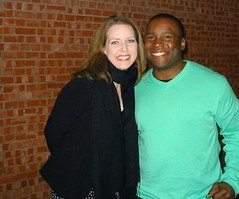
Amy Pfrimmer, Chauncey Packer in Manon Lescaut / photo Jennifer L Beckman Green
Originally uploaded by trudeau
Monday, April 27, 2009
Fine Arts Survey and cuisine: from California Roll sushi to a Michelin 3-star Bistro
Cuisine Project in Fine Arts:
The key to studying foreign and high cuisines is expanding one's awareness of ingredients, of classic dishes, of chefs and traditions, of types of restaurants and of vocabulary and literature.
Each student will choose a type of cuisine and make a presentation using no less than 10 images.
Each image will have
- brief, bulleted info on the category / nationality
- dish names
- ingredients
- cooking styles
- notable chefs and authors, where appilcable
- map
Due Mon, May 4
15 pts
Google Docs
Ex:
Cusine Francaise
- restaurant is from the French "restuare," to rest.
- Escoffier and other chefs have written guides to the elaborate sauces of classic cooking
- Each region has its own cuisine as well as wines: Bordeaux, Burgundy, etc
- Cheeses, fromage, are equally important. Ex: brie, camembert, roquefort.
- Kings of France and the wealthy class of Europe have driven the art of French cuisine to a rarified height.
- to sautee (a French term also used in dance) le champignons in sauce buerre is an example of the vocab known by gourmets across the world.
The key to studying foreign and high cuisines is expanding one's awareness of ingredients, of classic dishes, of chefs and traditions, of types of restaurants and of vocabulary and literature.
Each student will choose a type of cuisine and make a presentation using no less than 10 images.
Each image will have
- brief, bulleted info on the category / nationality
- dish names
- ingredients
- cooking styles
- notable chefs and authors, where appilcable
- map
Due Mon, May 4
15 pts
Google Docs
Ex:
Cusine Francaise
- restaurant is from the French "restuare," to rest.
- Escoffier and other chefs have written guides to the elaborate sauces of classic cooking
- Each region has its own cuisine as well as wines: Bordeaux, Burgundy, etc
- Cheeses, fromage, are equally important. Ex: brie, camembert, roquefort.
- Kings of France and the wealthy class of Europe have driven the art of French cuisine to a rarified height.
- to sautee (a French term also used in dance) le champignons in sauce buerre is an example of the vocab known by gourmets across the world.
Wednesday, April 22, 2009
Evaluating author Dallas Clayton
A review of the presentation by author-illustrator-skateboarder Dallas Clayton will comprise the following elements:
- quote from Clayton or his book.
- physical description
- An Awesome Book
- student response
For 10 pts please email me a brief essay using these guidelines.
See more at dallasclayton.com
- quote from Clayton or his book.
- physical description
- An Awesome Book
- student response
For 10 pts please email me a brief essay using these guidelines.
See more at dallasclayton.com
Tuesday, April 21, 2009
Yo-Yo Ma: cellist and one of the most important classical musicans of this era

Yo-Yo Ma - World Economic Forum Annual Meeting Davos 2008
Originally uploaded by World Economic Forum
Ma was a prodigy, beginning cello at age 4. He studied at the Juilliard School of Music with Leonard Rose and attended Columbia University before ultimately enrolling at Harvard University.
Ma currently plays with his own Silk Road Ensemble, which has the goal of bringing together musicians from diverse countries all of which are historically linked via the Silk Road, and records on the Sony Classical label.
He has recorded over 75 albums, 15 of which are Grammy Award winners. Among his stellar performances across the world: he played for the Barack Obama inauguration.
His recordings and performances of the Johann Sebastian Bach: Cello Suites recorded in 1983 and again in 1994-1997 are particularly acclaimed.
Predecessor to the piano: the harpsichord
A harpsichord is a musical instrument played by means of a keyboard. It produces sound by plucking a string when each key is pressed, says Wikipedia.
Also in the harpsichord family are the smaller virginals, the muselar or muselaar virginals and the spinet (but not the clavichord which is a hammered instrument).
The harpsichord was widely used in baroque music. It became less popular following the invention of the piano, but its distinctive sound is still used in contemporary music.
The harpsichord was most probably invented in the late Middle Ages. By the 1500s, harpsichord makers in Italy were making lightweight instruments with low string tension. A different approach was taken in Flanders starting in the late 1500s, notably by the Ruckers family. Their harpsichords used a heavier construction and produced a more powerful and distinctive tone. They included the first harpsichords with two keyboards, used for transposition.
The Flemish instruments served as the model for 18th century harpsichord construction in other nations. In France, the double keyboards were adapted to control different choirs of strings, making a musically more flexible instrument. Instruments from the peak of the French tradition, by makers such as the Blanchet family and Pascal Taskin, are among the most widely admired of all harpsichords, and are frequently used as models for the construction of modern instruments. In England, the Kirkman and Shudi firms produced sophisticated harpsichords of great power and sonority. German builders extended the sound repertoire of the instrument by adding sixteen foot and two foot choirs; these instruments have recently served as models for modern builders.
In the late 18th century the harpsichord was supplanted by the piano and almost disappeared from view for most of the 19th century.
Also in the harpsichord family are the smaller virginals, the muselar or muselaar virginals and the spinet (but not the clavichord which is a hammered instrument).
The harpsichord was widely used in baroque music. It became less popular following the invention of the piano, but its distinctive sound is still used in contemporary music.
The harpsichord was most probably invented in the late Middle Ages. By the 1500s, harpsichord makers in Italy were making lightweight instruments with low string tension. A different approach was taken in Flanders starting in the late 1500s, notably by the Ruckers family. Their harpsichords used a heavier construction and produced a more powerful and distinctive tone. They included the first harpsichords with two keyboards, used for transposition.
The Flemish instruments served as the model for 18th century harpsichord construction in other nations. In France, the double keyboards were adapted to control different choirs of strings, making a musically more flexible instrument. Instruments from the peak of the French tradition, by makers such as the Blanchet family and Pascal Taskin, are among the most widely admired of all harpsichords, and are frequently used as models for the construction of modern instruments. In England, the Kirkman and Shudi firms produced sophisticated harpsichords of great power and sonority. German builders extended the sound repertoire of the instrument by adding sixteen foot and two foot choirs; these instruments have recently served as models for modern builders.
In the late 18th century the harpsichord was supplanted by the piano and almost disappeared from view for most of the 19th century.
Monday, April 20, 2009
Senior skip day: The Last Lullaby, the Jeffrey Goodman movie
The Last Lullaby will be screening May 1, 2 & 3 in the Regal Cinema at the Louisiana Boardwalk, says Jeffrey Goodman. "There will be five screenings per day: 11:30, 2:00, 4:30, 7:00, and 9:30. I will be there to introduce each of the 15 screenings, and I will be there to answer questions with the audiences following each of the 15 screenings."
Our trailer is now online. Please take a look at it when you have a chance, either on:
a. Vimeo (http://www.vimeo.com/3914678) or
b. Youtube (http://www.youtube.com/watch?v=axMvNmxFcqo)
Our trailer is now online. Please take a look at it when you have a chance, either on:
a. Vimeo (http://www.vimeo.com/3914678) or
b. Youtube (http://www.youtube.com/watch?v=axMvNmxFcqo)
Sunday, April 19, 2009
Artist Rafael Rozendaal works mostly in clever web sites
He says . . .
Rafaël Rozendaal (1980)
Dutch and Brazilian nationality
Most people know me for my websites. My subjects range from clouds to blood, from hands to farts, from hills to dollars, from doors to fire. A friend of mine asked 'what is your leading path?'
I cannot answer that question yet.
Please see http://www.muchbetterthanthis.com/.
Also see a wealth of similar sites at http://www.newrafael.com/.
British painter Banksy, one of the world's foremost street artists
Quotable lines from the British artist known as Banksy:
If you have a statue in the city centre, you could go past it every day on your way to school and never even notice it, right - but as soon as someone puts a traffic cone on its head, you've made your own sculpture. — from The Independent[70] ”
“ The thing I hate the most about advertising is that it attracts all the bright, creative and ambitious young people, leaving us mainly with the slow and self-obsessed to become our artists. Modern art is a disaster area. Never in the field of human history has so much been used by so many to say so little. ”
“ People say graffiti is ugly, irresponsible and childish... but that's only if it's done properly. "
If you have a statue in the city centre, you could go past it every day on your way to school and never even notice it, right - but as soon as someone puts a traffic cone on its head, you've made your own sculpture. — from The Independent[70] ”
“ The thing I hate the most about advertising is that it attracts all the bright, creative and ambitious young people, leaving us mainly with the slow and self-obsessed to become our artists. Modern art is a disaster area. Never in the field of human history has so much been used by so many to say so little. ”
“ People say graffiti is ugly, irresponsible and childish... but that's only if it's done properly. "
Street art on its way to fine art: graffiti
Jumping a fence at night with paint and supplies in hand - the destination is a wall that, in your imagination, is a public gallery. Cops and escape are much on your mind. So is the history of art, meaning Banksy and Shepard Fairey and a million anonymous hobos, dispossessed youths and anarchist painters.
You have to be young or rebelliously old to enjoy the ramifications of graffiti.
For most people, graffiti is like, so 80's. That means one of 2 things: they might Love the 80's, in which case graffiti gets a free ride. Or they may see street art as hideously over-exposed. If you're Republican, graffiti has little chance of approval no matter What the perspective.
But graffiti has revivified itself stylistically through stencil and wheat paste poster modes. Indeed, Shepard Fairey's "Hope" piece for Obama has given poster graffiti a very positive cachet for many people - most of them Democrats, to be sure.
In graffiti the classics include:
* Roman and Greek examples
* historic hobo symbols
* "Kilroy was here," WWII style.
* "Dick Nixon before he dicks you," 70's anti-Vietnam war style.
* Berlin Wall anti-communist writing.
* NYC train wildstyle tagging; associated w hip-hop culture.
* full-scale satiric paintings a la Banksy (see illus above).
* Jean-Michel Basquiat-style, NYC, 80's.
* Keith Haring-style, NYC, 80's.
* Commercial work as sponsored by Adidas and Sony.
* As seen in video games.
* Sao Paulo surreal.
* Wheat paste and Sticker art.
* Stencil art.
Classic graffiti has the spirit of anarchy.
From Wikipedia:
Terrance Lindall, an artist and executive director of the Williamsburg Art and Historic Center, said regarding graffiti and the exhibition:[52]
"Graffiti is revolutionary, in my opinion," he says, "and any revolution might be considered a crime. People who are oppressed or suppressed need an outlet, so they write on walls—it’s free."
A 2006 exhibition at the Brooklyn Museum displayed graffiti as an art form that began in New York's outer boroughs and reached great heights in the early '80s with the work of Crash, Lee, Daze, Keith Haring and Jean-Michel Basquiat.
The developments of graffiti art which took place in art galleries and colleges as well as "on the street" or "underground", contributed to the resurfacing in the 1990s of a far more overtly politicized art form in the subvertising, culture jamming or tactical media movements.
In most countries, graffiti art remains illegal in many forms except when using non-permanent paint. Since the 1990s a growing number of artists are switching to non-permanent paints for a variety of reasons -- but primarily because is it difficult for the police to apprehend and for the courts to sentence or even convict a person for a protest that is as fleeting and less intrusive than marching in the streets. In some communities, such impermanent works survive longer than works created with permanent paints because the community views the work in the same vein as that of the civil protestor who marches in the street -- such protest are impermanent but effective nevertheless.
The British street artist Banksy has become one of the world's pre-eminent practicioners and success stories. Please read about him by clicking here.
You have to be young or rebelliously old to enjoy the ramifications of graffiti.
For most people, graffiti is like, so 80's. That means one of 2 things: they might Love the 80's, in which case graffiti gets a free ride. Or they may see street art as hideously over-exposed. If you're Republican, graffiti has little chance of approval no matter What the perspective.
But graffiti has revivified itself stylistically through stencil and wheat paste poster modes. Indeed, Shepard Fairey's "Hope" piece for Obama has given poster graffiti a very positive cachet for many people - most of them Democrats, to be sure.
In graffiti the classics include:
* Roman and Greek examples
* historic hobo symbols
* "Kilroy was here," WWII style.
* "Dick Nixon before he dicks you," 70's anti-Vietnam war style.
* Berlin Wall anti-communist writing.
* NYC train wildstyle tagging; associated w hip-hop culture.
* full-scale satiric paintings a la Banksy (see illus above).
* Jean-Michel Basquiat-style, NYC, 80's.
* Keith Haring-style, NYC, 80's.
* Commercial work as sponsored by Adidas and Sony.
* As seen in video games.
* Sao Paulo surreal.
* Wheat paste and Sticker art.
* Stencil art.
Classic graffiti has the spirit of anarchy.
From Wikipedia:
Terrance Lindall, an artist and executive director of the Williamsburg Art and Historic Center, said regarding graffiti and the exhibition:[52]
"Graffiti is revolutionary, in my opinion," he says, "and any revolution might be considered a crime. People who are oppressed or suppressed need an outlet, so they write on walls—it’s free."
A 2006 exhibition at the Brooklyn Museum displayed graffiti as an art form that began in New York's outer boroughs and reached great heights in the early '80s with the work of Crash, Lee, Daze, Keith Haring and Jean-Michel Basquiat.
The developments of graffiti art which took place in art galleries and colleges as well as "on the street" or "underground", contributed to the resurfacing in the 1990s of a far more overtly politicized art form in the subvertising, culture jamming or tactical media movements.
In most countries, graffiti art remains illegal in many forms except when using non-permanent paint. Since the 1990s a growing number of artists are switching to non-permanent paints for a variety of reasons -- but primarily because is it difficult for the police to apprehend and for the courts to sentence or even convict a person for a protest that is as fleeting and less intrusive than marching in the streets. In some communities, such impermanent works survive longer than works created with permanent paints because the community views the work in the same vein as that of the civil protestor who marches in the street -- such protest are impermanent but effective nevertheless.
The British street artist Banksy has become one of the world's pre-eminent practicioners and success stories. Please read about him by clicking here.
Thursday, April 9, 2009
JS Bach, Leipzig
Johann Sebastian Bach (1685 – 1750) was a German composer and organist whose sacred and secular works for choir, orchestra, and solo instruments drew together the strands of the Baroque period and brought it to its ultimate maturity.[1]
Although he introduced no new forms, he enriched the prevailing German style with a robust contrapuntal technique, an unrivalled control of harmonic and motivic organisation in composition for diverse instrumentation, and the adaptation of rhythms and textures from abroad, particularly Italy and France, says Wikipedia.
While Bach's fame as an organist was great during his lifetime, he was not particularly well-known as a composer. His adherence to Baroque forms and contrapuntal style was considered "old-fashioned" by his contemporaries, especially late in his career when the musical fashion tended towards Rococo and later Classical styles.
A revival of interest and performances of his music began early in the 19th century, and he is now widely considered to be one of the greatest composers in the Western tradition.
Mozart, Beethoven, and Chopin were among his most prominent admirers.
He fathered 20 children by 2 wives. Was a devout Lutheran. Worked longest in the city of Leipzig.
Toccata and Fugue in D minor has been enormously popular and has been used frequently by rock musicians. His work called Air on a G String (really) is very widely known and used in much media. His solo work for cello is a favorite of your teacher. The Brandenberg Concertos are widely regarded as among the finest musical compositions of the Baroque era.
During his life he composed more than 1,000 works.
Bach died in 1750 at the age of 65. A contemporary newspaper reported the cause of death was "from the unhappy consequences of the very unsuccessful eye operation".[14] Some modern historians speculate the cause of death was a stroke complicated by pneumonia.[
Although he introduced no new forms, he enriched the prevailing German style with a robust contrapuntal technique, an unrivalled control of harmonic and motivic organisation in composition for diverse instrumentation, and the adaptation of rhythms and textures from abroad, particularly Italy and France, says Wikipedia.
While Bach's fame as an organist was great during his lifetime, he was not particularly well-known as a composer. His adherence to Baroque forms and contrapuntal style was considered "old-fashioned" by his contemporaries, especially late in his career when the musical fashion tended towards Rococo and later Classical styles.
A revival of interest and performances of his music began early in the 19th century, and he is now widely considered to be one of the greatest composers in the Western tradition.
Mozart, Beethoven, and Chopin were among his most prominent admirers.
He fathered 20 children by 2 wives. Was a devout Lutheran. Worked longest in the city of Leipzig.
Toccata and Fugue in D minor has been enormously popular and has been used frequently by rock musicians. His work called Air on a G String (really) is very widely known and used in much media. His solo work for cello is a favorite of your teacher. The Brandenberg Concertos are widely regarded as among the finest musical compositions of the Baroque era.
During his life he composed more than 1,000 works.
Bach died in 1750 at the age of 65. A contemporary newspaper reported the cause of death was "from the unhappy consequences of the very unsuccessful eye operation".[14] Some modern historians speculate the cause of death was a stroke complicated by pneumonia.[
Stravinsky's ballet, The Firebird
The Firebird (French: L'Oiseau de feu) is a 1910 ballet by Igor Stravinsky and choreographed by Michel Fokine. The ballet is based on Russian folk tales of the magical glowing bird of the same name that is both a blessing and a curse to its captor, says Wikipedia.
Stravinsky's ballet centers on the journey of its hero, Prince Ivan. Ivan enters the magical realm of Kashchei the Immortal; all of the magical objects and creatures of Kashchei are herein represented by a chromatic descending motif, usually in the strings.
While wandering in the gardens, he sees and chases the Firebird. The Firebird, once caught by Ivan, begs for its life and ultimately agrees to assist Ivan in exchange for eventual freedom.
Next, Prince Ivan sees thirteen princesses, with one of whom he falls in love. The next day, Ivan chooses to confront Kashchei to ask to marry one of the princesses; the two talk and eventually begin quarreling.
When Kashchei sends his magical creatures after Ivan, the Firebird, true to its pledge, intervenes, bewitching the creatures and making them dance an elaborate, energetic dance (the "Infernal Dance"). The creatures and Kashchei then fall asleep; however, Kashchei awakens and is then sent into another dance by the Firebird.
While Kashchei is bewitched by the Firebird she tells Ivan the secret to Kashchei's immortality and Ivan destroys it killing Kashchei. With Kashchei gone and his magic broken, the magical creatures and the palace all disappear, and all of the "real" beings (including the princesses) awaken and, with one final fleeting appearance from the Firebird, celebrate their victory.
Stravinsky's ballet centers on the journey of its hero, Prince Ivan. Ivan enters the magical realm of Kashchei the Immortal; all of the magical objects and creatures of Kashchei are herein represented by a chromatic descending motif, usually in the strings.
While wandering in the gardens, he sees and chases the Firebird. The Firebird, once caught by Ivan, begs for its life and ultimately agrees to assist Ivan in exchange for eventual freedom.
Next, Prince Ivan sees thirteen princesses, with one of whom he falls in love. The next day, Ivan chooses to confront Kashchei to ask to marry one of the princesses; the two talk and eventually begin quarreling.
When Kashchei sends his magical creatures after Ivan, the Firebird, true to its pledge, intervenes, bewitching the creatures and making them dance an elaborate, energetic dance (the "Infernal Dance"). The creatures and Kashchei then fall asleep; however, Kashchei awakens and is then sent into another dance by the Firebird.
While Kashchei is bewitched by the Firebird she tells Ivan the secret to Kashchei's immortality and Ivan destroys it killing Kashchei. With Kashchei gone and his magic broken, the magical creatures and the palace all disappear, and all of the "real" beings (including the princesses) awaken and, with one final fleeting appearance from the Firebird, celebrate their victory.
Tuesday, April 7, 2009
Video projects the week after Spring break
Video projects need not be lengthy to be effective! In fact, something at the 1 to 3 minute length is perfect. You can learn a lot about composing and editing in a project that results in a 2-minute product.
Fine Arts Class' next project is to produce a short video.
Scoring will follow these guidelines -
1. Written plan of action.
2. Film quality -
- video well-lighted.
- video varying between long shot, medium and close-up.
- audio of adequate volume - perhaps the most difficult part of the work.
- edited - for brevity.
- Titling: snappy title, explanatory subtitle
- credits: names
- music or sound effects.
3. Presentation in class.
Fine Arts Class' next project is to produce a short video.
Scoring will follow these guidelines -
1. Written plan of action.
2. Film quality -
- video well-lighted.
- video varying between long shot, medium and close-up.
- audio of adequate volume - perhaps the most difficult part of the work.
- edited - for brevity.
- Titling: snappy title, explanatory subtitle
- credits: names
- music or sound effects.
3. Presentation in class.
Monday, April 6, 2009
Louis XIV moved his capital to the Chateau de Versailles to consolidate power and escape the proletariat
By moving his court and government to Versailles, Louis XIV hoped to extract more control of the government from the nobility, says Wikipedia. It also gave him distance from the population of Paris.
All the power of France emanated from this center: there were government offices here, as well as the homes of thousands of courtiers, their retinues, and all the attendant functionaries of court (Solnon, 1987). By requiring that nobles of a certain rank and position spend time each year at Versailles, Louis prevented them from developing their own regional power at the expense of his own and kept them from countering his efforts to centralise the French government in an absolute monarchy (Bluche, 1986, 1991; Bendix, 1978; Solnon, 1987).
The meticulous and strict court etiquette that Louis established, which overwhelmed his heirs with its petty boredom, was epitomised in the elaborate ceremonies and exacting procedures that accompanied his rising in the morning, known as the Lever, divided into a petit lever for the most important and a grand lever for the whole court. Like other French court manners, étiquette was quickly imitated in other European courts (Benichou, 1948; Bluche, 1991; Solnon, 1987).
The expansion of the château became synonymous with the absolutism of Louis XIV (Bluche, 1986, 1991). In 1661, following the death of Cardinal Mazarin, chief minister of the government, Louis had declared that he would be his own chief minister. The idea of establishing the court at Versailles was conceived to ensure that all of his advisors and provincial rulers would be kept close to him. He feared that they would rise up against him and start a revolt. He thought that if he kept all of his potential threats near him, that they would be powerless.
After the disgrace of Nicolas Fouquet in 1661 — Louis claimed the finance minister would not have been able to build his grand château at Vaux-le-Vicomte without having embezzled from the crown — Louis, after the confiscation of Fouquet’s state, employed the talents of Le Vau, Le Nôtre, and Le Brun, who all had worked on Vaux-le-Vicomte, for his building campaigns at Versailles and elsewhere.
All the power of France emanated from this center: there were government offices here, as well as the homes of thousands of courtiers, their retinues, and all the attendant functionaries of court (Solnon, 1987). By requiring that nobles of a certain rank and position spend time each year at Versailles, Louis prevented them from developing their own regional power at the expense of his own and kept them from countering his efforts to centralise the French government in an absolute monarchy (Bluche, 1986, 1991; Bendix, 1978; Solnon, 1987).
The meticulous and strict court etiquette that Louis established, which overwhelmed his heirs with its petty boredom, was epitomised in the elaborate ceremonies and exacting procedures that accompanied his rising in the morning, known as the Lever, divided into a petit lever for the most important and a grand lever for the whole court. Like other French court manners, étiquette was quickly imitated in other European courts (Benichou, 1948; Bluche, 1991; Solnon, 1987).
The expansion of the château became synonymous with the absolutism of Louis XIV (Bluche, 1986, 1991). In 1661, following the death of Cardinal Mazarin, chief minister of the government, Louis had declared that he would be his own chief minister. The idea of establishing the court at Versailles was conceived to ensure that all of his advisors and provincial rulers would be kept close to him. He feared that they would rise up against him and start a revolt. He thought that if he kept all of his potential threats near him, that they would be powerless.
After the disgrace of Nicolas Fouquet in 1661 — Louis claimed the finance minister would not have been able to build his grand château at Vaux-le-Vicomte without having embezzled from the crown — Louis, after the confiscation of Fouquet’s state, employed the talents of Le Vau, Le Nôtre, and Le Brun, who all had worked on Vaux-le-Vicomte, for his building campaigns at Versailles and elsewhere.
Le quiz du Louis XIV
1. Louis XIV was the king who sparked the French Revolution of 1789. T / F
2. The Palace of Versailles is in Paris near the bank of the River Seine. T / F
3. The famous queen of King Louis XIV was Marie Antoinette. T / F
4. There is little doubt that Louis XIV was homosexual. T / F
5. How vast was Versailles? For instance, how many rooms?
a) 300 b) 700 c) 999.
6. Louis forced the independent-minded noblemen of France to change something about their lives. a) their residence. b) number of servants allowed. c) all forced to serve in the military.
7. Consider the magnificent chateau created by Nicholas Fouquet, the Finance Minster under Louis XIV. Called Vaux le Vicomte, when it was completed it was finer than anything owned by the King. What was the fate of the Minister of France once his chateau had been seen by the King?
8. Why did Louis XIV change his residence from the Palais du Louvre to the Chateau de Versailles?
9. To win the favor of Louis XIV at Versailles, a nobleman would be expected to take what sort of lessons?
10. Based on a role that he danced in a grand fete, what was the famous nickname of Louis XIV? And en Francais?
1. While he spent too much of France's money on wars and luxury, the revolution did not begin until the reign of Louis XVI, some 60 years after the reign of Louis XIV.
2. Versailles is about 11 miles south of Paris. Today it is a city and a suburb of Paris.
3. Marie Antoinette was a victim of the Revolution and the guillotine in 1793; her husband was Louis XVI, and went to his execution in 1792.
4. Louis XIV was married twice and fathered many children. He also had several mistresses. So we assume that, despite his feminine appearance in royal portraits, he was heterosexual.
5. Wikipedia lists the number of rooms as 700.
6. Louis commanded all the nobles to move into Versailles. There he was able to pit them against each other and bring autocratic unity to France.
7. Fouquet was imprisoned for embezzling the King's money. The designers and craftsmen who created Vaux le Vicomte were taken to Versailles to create an even grander residence.
8. Louis changed his residence when he realized that the royal family was not safe from the rabble in Paris.
9. Louis loved dance, particularly ballet. To be his friend was to take dance lessons.
10. The Sun King: Le Roi Soleil.
2. The Palace of Versailles is in Paris near the bank of the River Seine. T / F
3. The famous queen of King Louis XIV was Marie Antoinette. T / F
4. There is little doubt that Louis XIV was homosexual. T / F
5. How vast was Versailles? For instance, how many rooms?
a) 300 b) 700 c) 999.
6. Louis forced the independent-minded noblemen of France to change something about their lives. a) their residence. b) number of servants allowed. c) all forced to serve in the military.
7. Consider the magnificent chateau created by Nicholas Fouquet, the Finance Minster under Louis XIV. Called Vaux le Vicomte, when it was completed it was finer than anything owned by the King. What was the fate of the Minister of France once his chateau had been seen by the King?
8. Why did Louis XIV change his residence from the Palais du Louvre to the Chateau de Versailles?
9. To win the favor of Louis XIV at Versailles, a nobleman would be expected to take what sort of lessons?
10. Based on a role that he danced in a grand fete, what was the famous nickname of Louis XIV? And en Francais?
1. While he spent too much of France's money on wars and luxury, the revolution did not begin until the reign of Louis XVI, some 60 years after the reign of Louis XIV.
2. Versailles is about 11 miles south of Paris. Today it is a city and a suburb of Paris.
3. Marie Antoinette was a victim of the Revolution and the guillotine in 1793; her husband was Louis XVI, and went to his execution in 1792.
4. Louis XIV was married twice and fathered many children. He also had several mistresses. So we assume that, despite his feminine appearance in royal portraits, he was heterosexual.
5. Wikipedia lists the number of rooms as 700.
6. Louis commanded all the nobles to move into Versailles. There he was able to pit them against each other and bring autocratic unity to France.
7. Fouquet was imprisoned for embezzling the King's money. The designers and craftsmen who created Vaux le Vicomte were taken to Versailles to create an even grander residence.
8. Louis changed his residence when he realized that the royal family was not safe from the rabble in Paris.
9. Louis loved dance, particularly ballet. To be his friend was to take dance lessons.
10. The Sun King: Le Roi Soleil.
Louis XIV moved his capita; to the Chateau de Versailles
Louis XIV had the Palace of Versailles, originally a hunting lodge built by his father, converted into a spectacular royal palace in a series of four major and distinct building campaigns, says Wikipedia.
By the end of the third building campaign, the château had taken on most of the appearance that it retains to this day, except for the current chapel built in the last decade of the reign. He officially moved there, along with the royal court, on 6 May 1682.
Louis had several reasons for creating such a symbol of extravagant opulence and stately grandeur, and for shifting the seat of the monarchy. The assertion that he did so because he hated Paris, however, is flawed as he did not cease to embellish his capital with glorious monuments while improving and developing it. On the other hand, contemporary writers such as Saint-Simon speculated that Louis viewed Versailles as an isolated power center where treasonous cabals could be more readily recognized.[15]
Versailles served as a dazzling and awe-inspiring setting for state affairs and for the reception of foreign dignitaries, where the attention was not shared with the capital and the people, but was assumed solely by the person of the king. Thus, many noblemen had perforce either to give up the cachet and opportunites associated with sharing in the king's company, or to depend entirely on the king for the grants and subsidies necessary to do so in proper style.[15] Instead of exercising power and potentially creating trouble, the nobles vied for the honour of dining at the king's table or the privilege of carrying a candlestick as the king retired to his bedroom.
From 1682, when King Louis XIV moved from Paris, until the royal family was forced to return to the capital in 1789, the Court of Versailles was the centre of power in Ancien Régime France. Versailles is therefore famous not only as a building, but as a symbol of the system of absolute monarchy which Louis XIV espoused.
By the end of the third building campaign, the château had taken on most of the appearance that it retains to this day, except for the current chapel built in the last decade of the reign. He officially moved there, along with the royal court, on 6 May 1682.
Louis had several reasons for creating such a symbol of extravagant opulence and stately grandeur, and for shifting the seat of the monarchy. The assertion that he did so because he hated Paris, however, is flawed as he did not cease to embellish his capital with glorious monuments while improving and developing it. On the other hand, contemporary writers such as Saint-Simon speculated that Louis viewed Versailles as an isolated power center where treasonous cabals could be more readily recognized.[15]
Versailles served as a dazzling and awe-inspiring setting for state affairs and for the reception of foreign dignitaries, where the attention was not shared with the capital and the people, but was assumed solely by the person of the king. Thus, many noblemen had perforce either to give up the cachet and opportunites associated with sharing in the king's company, or to depend entirely on the king for the grants and subsidies necessary to do so in proper style.[15] Instead of exercising power and potentially creating trouble, the nobles vied for the honour of dining at the king's table or the privilege of carrying a candlestick as the king retired to his bedroom.
From 1682, when King Louis XIV moved from Paris, until the royal family was forced to return to the capital in 1789, the Court of Versailles was the centre of power in Ancien Régime France. Versailles is therefore famous not only as a building, but as a symbol of the system of absolute monarchy which Louis XIV espoused.
The most formal of Fine Arts dance forms, ballet
Ballet is a formalized type of performative dance, the origins of which date lay in sixteenth- and seventeenth-century French courts, and which was further developed in England, Italy, and Russia as a concert dance form.
The early performances preceded the intervention of the proscenium stage and were presented in large chambers with the most of the audience seated on tiers or galleries on three sides of the dancing floor, says Wikipedia.
The early ballet dancers were not as highly skilled as they are now [1] It has since become a highly technical form of dance with its own vocabulary. It is primarily performed with the accompaniment of classical music. It has been influential as a form of dance globally and is taught in ballet schools around the world, which use their own cultures and societies to inform the art. Ballet dance works (ballets) are choreographed, and also include mime, acting, and are set to music (usually orchestral but occasionally vocal).
It is best known in the form of Late Romantic Ballet Blanc, which preoccupies itself with the female dancer to the exclusion of almost all else, focusing on pointe work, flowing, precise acrobatic movements, and often presenting the dancers in the conventional short white French tutu. Later developments include Expressionist ballet, Neoclassical ballet, and elements of Modern dance.
The etymology of the word "ballet" is related to the art form's history. The word ballet comes from the French and was borrowed into English around the 17th century. The French word in turn has its origins in Italian balletto, a diminutive of ballo (dance). Ballet ultimately traces back to Latin ballare, meaning to dance.
Most of the terminology of ballet is French.
The early performances preceded the intervention of the proscenium stage and were presented in large chambers with the most of the audience seated on tiers or galleries on three sides of the dancing floor, says Wikipedia.
The early ballet dancers were not as highly skilled as they are now [1] It has since become a highly technical form of dance with its own vocabulary. It is primarily performed with the accompaniment of classical music. It has been influential as a form of dance globally and is taught in ballet schools around the world, which use their own cultures and societies to inform the art. Ballet dance works (ballets) are choreographed, and also include mime, acting, and are set to music (usually orchestral but occasionally vocal).
It is best known in the form of Late Romantic Ballet Blanc, which preoccupies itself with the female dancer to the exclusion of almost all else, focusing on pointe work, flowing, precise acrobatic movements, and often presenting the dancers in the conventional short white French tutu. Later developments include Expressionist ballet, Neoclassical ballet, and elements of Modern dance.
The etymology of the word "ballet" is related to the art form's history. The word ballet comes from the French and was borrowed into English around the 17th century. The French word in turn has its origins in Italian balletto, a diminutive of ballo (dance). Ballet ultimately traces back to Latin ballare, meaning to dance.
Most of the terminology of ballet is French.
Friday, April 3, 2009
Mozart's Requiem at St John Berchmans, Shreveport, on Sun, May 3 at 3 pm
Wolgnag Amadeus Mozart's final composition, the Requiem. Hear it with three choirs, orchestra and soloists in a beautiful cathedral on Fairfield Ave.
Wednesday, April 1, 2009
Wolfgang Amadeus Mozart: voracious learner, profoundly influential in the graceful as well as the dark and passionate
Wolfgang Amadeus Mozart (IPA: [ˈvɔlfgaŋ amaˈdeus ˈmoːtsart], full name Johann Chrysostom Wolfgang Amadeus Mozart[1] (27 January 1756 – 5 December 1791), was a prolific and influential composer of the Classical era. He composed over six hundred works, says Wikipedia, many acknowledged as pinnacles of symphonic, concertante, chamber, piano, operatic, and choral music; and he is among the most enduringly popular of classical composers.
Mozart showed prodigious ability from his earliest childhood in Salzburg.
Already competent on keyboard and violin, he composed from the age of five and performed before European royalty; at seventeen he was engaged as a court musician in Salzburg, but grew restless and traveled in search of a better position, always composing abundantly.
Visiting Vienna in 1781 he was dismissed from his Salzburg position and chose to stay in the capital, where over the rest of life he achieved fame but little financial security. The final years in Vienna yielded many of his best-known symphonies, concertos, and operas, and the Requiem.
The circumstances of his early death have been much mythologized. He was survived by his wife Constanze and two sons.
Mozart always learned voraciously from others, and developed a brilliance and maturity of style that encompassed the light and graceful along with the dark and passionate—the whole informed by a vision of humanity "redeemed through art, forgiven, and reconciled with nature and the absolute".[2]
His influence on all subsequent Western art music is profound. Beethoven wrote his own early compositions in the shadow of Mozart, of whom Joseph Haydn wrote that "posterity will not see such a talent again in 100 years".[3]
Mozart showed prodigious ability from his earliest childhood in Salzburg.
Already competent on keyboard and violin, he composed from the age of five and performed before European royalty; at seventeen he was engaged as a court musician in Salzburg, but grew restless and traveled in search of a better position, always composing abundantly.
Visiting Vienna in 1781 he was dismissed from his Salzburg position and chose to stay in the capital, where over the rest of life he achieved fame but little financial security. The final years in Vienna yielded many of his best-known symphonies, concertos, and operas, and the Requiem.
The circumstances of his early death have been much mythologized. He was survived by his wife Constanze and two sons.
Mozart always learned voraciously from others, and developed a brilliance and maturity of style that encompassed the light and graceful along with the dark and passionate—the whole informed by a vision of humanity "redeemed through art, forgiven, and reconciled with nature and the absolute".[2]
His influence on all subsequent Western art music is profound. Beethoven wrote his own early compositions in the shadow of Mozart, of whom Joseph Haydn wrote that "posterity will not see such a talent again in 100 years".[3]
Subscribe to:
Posts (Atom)
